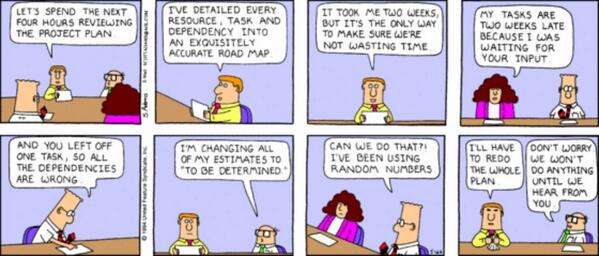I was chatting to a friend recently, he is a manager of an IT department and I used to manage a software department before I became a Agile Coach so we tend to talk a lot about management techniques and especially how a lot of the successful traditional techniques map to an agile work environment.
It was performance review time and the topic of conversation got around to a frustrating belief by some staff that working long hours without being asked is something that should have an implied reward. That working long hours is in itself a reason to be praised.

Warning signs
I can’t speak for all managers, but for the two of us I can say that we consider it to be the opposite, when someone works late on a regular basis without being asked, we see that as a bad thing, it is a red-flag. Certainly not to be commended and very likely a sign of deeper problems.
I used to pride myself on being a good manager, I felt I was fair and sought to do what was best for my employees and the business, sometimes it was a fine line and often not easy. But one of my strongest principles was to be fair. I would never assign someone more work than I felt they could handle (that is not to say I didn’t seek to challenge them), I would generally discuss in advance what they felt was fair and I would always say very clearly that they should come back to me if they had problems, and I would review on a regular basis – usually at least weekly.
As an Agile Coach I have obviously changed my behaviour a lot and learned so much along the way but generally speaking it could be said that the roles are reversed, the team decide what they feel they can commit to and they review with each other on a regular basis (at the daily stand-up) and can ask if they need help, they should assign themselves small chunks of work and no more than can be reasonably achieved.
Have I assigned too much?
In either of these scenarios there should be no scope for voluntary, unpaid, overtime. In the case of assigned work: if you cannot get it done in the allotted time then it is a failure of my management – either I have incorrectly assessed the amount of work or I have misjudged the individuals capability to do it, and unless I have opportunity to be aware of that I cannot correct my behaviour and the cycle will repeat.
The same is true in Agile, whichever chosen framework you use the model is built on empirical evidence, if your forecasts are off you learn and adjust next time. Working overtime hides problems and perpetuates failing cycles, it also causes an imbalance in the team, it makes pair programming difficult and sends mixed messages to others. Very simply as a team manager or a self-organizing Team you cannot fix a problem you don’t know about. Overtime is analogous to cards not on the board, it is hiding work, this is very damaging to a self-organising team.
Rewarding bad behaviour
So should you reward someone for working late, for their dedication and loyalty? or should they be reprimanded for their lack of transparency, or their inefficiency of working? Are they displaying a lack of courage in not challenging an unrealistic expectation? Are they stretching work to appear more busy? Should we reward their failure to communicate an excessive workload, or for failing to ask for help with their lack of knowledge/training/understanding to achieve the objective at hand?
As a manager if I ask you to work overtime I would do so with a very heavy heart, I know that it is not good for you, I know it is not good for the business and any gain is short-term and short-lived. It will only be in exceptional circumstances, where there is justification or benefit in working overtime.
As a member of a self-organizing team you should set those same standards for yourself: You should know that it is not good for you or the team, You should know it is not good for the business and any gain is short-lived.
So if you do voluntary overtime which conflicts with our team plans or expectations please don’t expect to be rewarded for it. That may sound harsh but I value communication far more than I value you giving extra time, especially if by doing so it is hiding problems elsewhere that we could and should be addressing.

Clarification
This is not a call to work to rule, this is a request to understand the difference between being a team player and expecting recognition and reward for setting yourself up as a martyr. By doing so, try to understand that you are working against the interests of the team, this is not behaviour we should be rewarding.
Sometimes it is necessary to work overtime but this should be a deliberate team decision with a clear objective. It should be open and transparent and should not be one person acting alone.
*Note when I saw reward, this is everything from a positive comment from leadership to financial reward. Sometimes leadership even acknowledging this behaviour is seen as a reward, the belief that your actions were noticed is quite an incentive for some.





















